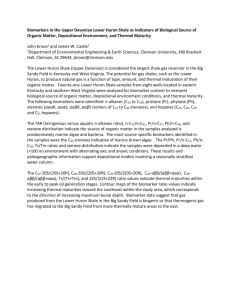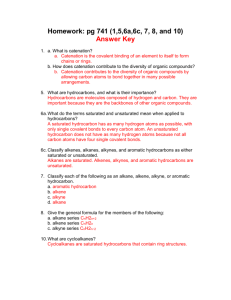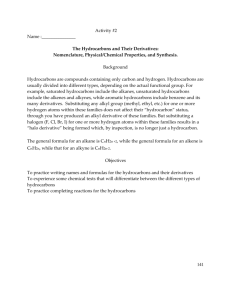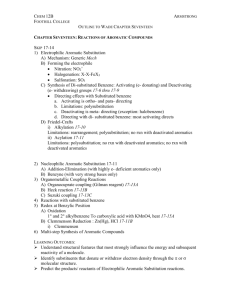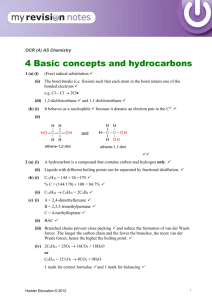CHEMICAL COMPOSITION AND PHYSICAL PROPERTIES OF
advertisement
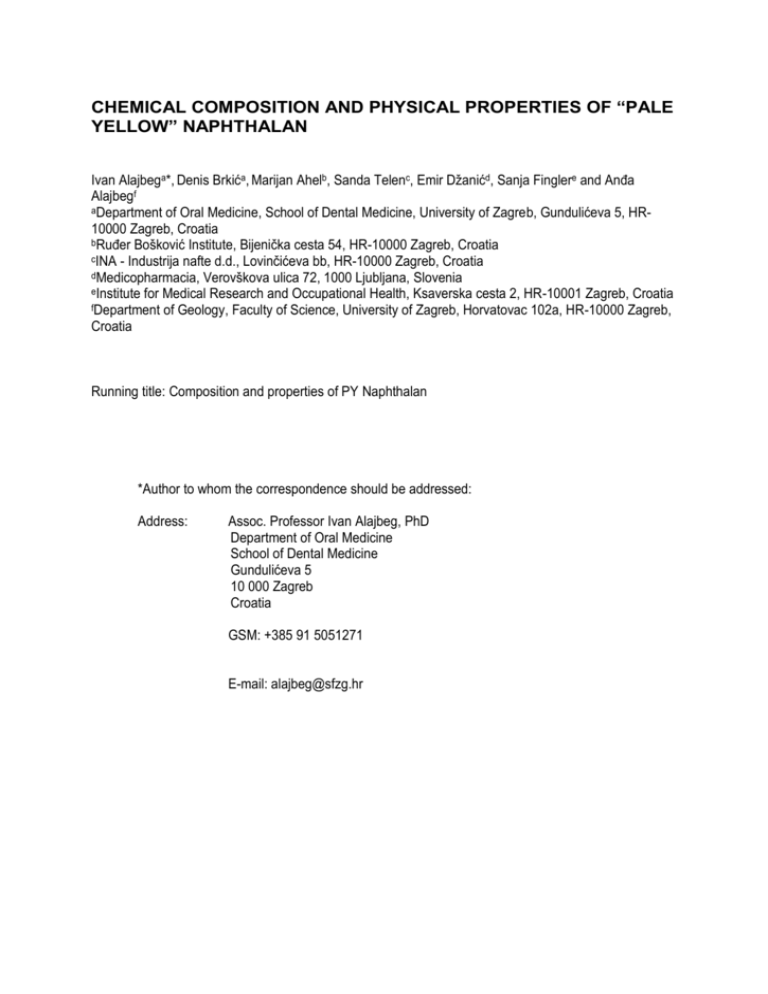
CHEMICAL COMPOSITION AND PHYSICAL PROPERTIES OF “PALE YELLOW” NAPHTHALAN Ivan Alajbega*, Denis Brkića, Marijan Ahelb, Sanda Telenc, Emir Džanićd, Sanja Finglere and Anđa Alajbegf aDepartment of Oral Medicine, School of Dental Medicine, University of Zagreb, Gundulićeva 5, HR10000 Zagreb, Croatia bRuđer Bošković Institute, Bijenička cesta 54, HR-10000 Zagreb, Croatia cINA - Industrija nafte d.d., Lovinčićeva bb, HR-10000 Zagreb, Croatia dMedicopharmacia, Verovškova ulica 72, 1000 Ljubljana, Slovenia eInstitute for Medical Research and Occupational Health, Ksaverska cesta 2, HR-10001 Zagreb, Croatia fDepartment of Geology, Faculty of Science, University of Zagreb, Horvatovac 102a, HR-10000 Zagreb, Croatia Running title: Composition and properties of PY Naphthalan *Author to whom the correspondence should be addressed: Address: Assoc. Professor Ivan Alajbeg, PhD Department of Oral Medicine School of Dental Medicine Gundulićeva 5 10 000 Zagreb Croatia GSM: +385 91 5051271 E-mail: alajbeg@sfzg.hr ABSTRACT The Pale Yellow (PY) Naphthalan is potentially a new treatment modality for some oral mucosal and dermatological diseases. Its chemical composition and physical properties were studied by standard and sophisticated methods. Special attention was paid to steranes and hopanes as favorable components and to aromatics as unfavorable compounds. PY Naphthalan is predominantly composed of saturated aliphatic hydrocarbons of different structures, and of hydrocarbons comprising aromatic ring(s) (<15 %). Among aromatics, 98 % were monoaromatics and 2 % diaromatics, while 16 polycyclic aromatic hydrocarbons designated by US Environmental Protection Agency as priority pollutants were found at minimum detectability levels. Steranes and hopanes appeared in native geogenic clusters of homologs and each of identified compounds was in native geogenic configuration. Steranes were in the range from norcholestanes up to propyl cholestanes and hopanes up to pentakishomohopanes. The content of steranes and hopanes was relatively high. Compared to the other naphthalan products, the composition of PY Naphthalan is remarkably improved. Physical properties make PY Naphthalan convenient for application. Keywords: naphthalan, steranes, hopanes, geogenic hydrocarbons, mineral oils, UCM - unresolved complex mixtures GRAPHICAL ABSTRACT INTRODUCTION In several ancient cultures, special types of mineral oils (i.e. naphtha, petroleum) had been used for centuries for traditional treatment of a wide scope of different diseases.1-3 In Azerbaijan, the application intensified towards the end of 19th century. It was relayed to a special mineral oil named „naphthalan“ which was applied as bath as well as ointments and creams produced at large scale in Germany until the 1st World War. In the former USSR the activities restarted and were followed by building a large hospital complex.1 By thorough study of their healing effects and/or composition, a few mineral oils in Croatia have been proven to be of naphthalan type.2-4 Systematic application of a refined fraction of Croatian naphthalan type mineral oils started at the Special Hospital Naftalan in Ivanić Grad (Croatia) in 1989. More than a dozen thousands of patients have already been treated there, mostly for skin diseases. The results of curing effects were reported to be good.3 Intensive interdisciplinary research on the composition and bioactivity of naphthalan followed. Geogenic steranes were indicated as potential bioactive agents influencing healing effects.5-12 On the one hand, molecular skeletons of some potentially bioactive geogenic steranes were similar to D-vitamins, steroid hormones and corticosteroid drugs.9 On the other hand, the research emphasized the problem associated with the presence of toxic polycyclic aromatic hydrocarbons (PAHs) which are common constituents of naphthalan oils13,14 as well as of non-refined naphthalan preparations.12 Following recommendations from the previous research, an improved naphthalan version, called Pale Yellow (PY) Naphthalan, has been developed. This product has a potential role in treatment of skin diseases and for treatment of oral mucosal diseases. Its sterane content and concentration of PAHs are the foci of this research. To the best of the authors’ knowledge, PY Naphthalan has not been characterized for chemical composition or for physical properties, yet. Because of its application in human diseases treatment, PY Naphthalan chemical composition and physical properties were thoroughly studied using a set of standard techniques as well as sophisticated instrumental techniques, including high resolution gas chromatography (HRGC), normal phase high performance liquid chromatography (NP-HPLC), proton nuclear magnetic resonance (1H NMR) spectroscopy and gas chromatography-mass spectrometry (GC- MS). Special attention was paid to characterization of sterane and hopane composition, as well as to the content of aromatics. The results are expected to be a contribution to a better understanding of the properties and structural features of the naphthalan preparations with the final goal to produce a highly bioactive naphthalan preparation maximally depleted in toxic constituents such as PAHs. EXPERIMENTAL The studied sample was a refined naphthalan preparation called PY Naphthalan. The experimental work comprised characterization of PY Naphthalan physical properties, elemental analysis, chemical group analyses and some detailed studies, including analysis of steranes and hopanes. The working conditions, which were previously published15-18 or set by standard test methods,19-21 could be found elsewhere. The non-standard procedures as GC and GC-MS experimental conditions are described here. Physical properties Physical properties of PY Naphthalan were determined by the following standard methods: density at 15 C according to ASTM D1298-05; viscosity index according to ISO 2909(2002); kinematic viscosity at the determined temperatures according to HRN EN ISO 3104(2002); pour point, C, according to ASTM D97-09; color (oils) according to ASTM D1500-07; corrosivity (Cu-plate) according to ASTM D130-04; flash point according to ASTM D92-10; simulated distillation according to ASTM D2887-08. Elemental analysis CHN analysis of PY Naphthalan was performed according to ASTM D5291-07 using a Leco CHNS-932 Analyzer (Leco, St. Joseph, MI, USA). Sulfur analysis was performed by wave dispersive X-ray according to HRN EN ISO 20884(2004) using a Thermo ARL Advant X analyzer. Chemical group analyses Chemical group analysis in PY Naphthalan was performed by recoding the 1H NMR spectra on a Bruker Avance 300 NMR spectrometer operating at 300.13 MHz and using a 5 mm probe. The PY Naphthalan sample was dissolved in deuterated chloroform at a volume fraction of 30 %. The chemical shift was referred to tetramethylsilane as internal standard. The experimental conditions were: pulse width 300; relaxation delay 10 s; number of scans 32. The PY Naphthalan structural characteristic and the content of paraffinic and aromatic hydrocarbons were determined on the basis of the 1H NMR spectral data and the boiling point range data. The precipitation of asphaltenes as well as open air liquid chromatography (OA LC), performed according to in-house developed methods in INA d.d., were used for separation of compound groups of different polarity. The type and ratio of aromatics were determined by NP-HPLC according to HRN EN 12916 (2006). The NP-HPLC analysis of aromatics was performed on a Varian 9000 liquid chromatograph (Varian, Walnut Creek, CA, USA) using a refractive index detector and a Zorbax NH2, 250 mm x 4.6 mm i.d., particle size 5 μm, chromatographic column with a polar propylamino silane stationary phase (Agilent Technologies, Palo Alto, CA, USA). n-Heptane was used as the mobile phase. Boiling point distribution by simulated distillation The gas chromatographic analysis was performed using a Varian 3800 gas chromatograph equipped with a split/splitless injector and a flame ionization detector (Varian, Walnut Creek, CA, USA). GC column and operating conditions were: a non-polar Factor Four VF-5 MS fused silica column, 30 m x 0.25 mm i.d., film thickness 0.25 µm (Varian); column temperature programmed from 35 C at 10 C min-1 to 319 C with a final hold of 40 min; injector temperature 300 C; splitting ratio 1:100; injection volume 1 µL; detector temperature 320 C; carrier gas helium; methane retention time 90 s at 50 C column temperature; data calculation by peak area normalization using the Varian Star Workstation 4.0 software; no response correction factors were used. Determination of hopanes and steranes by GC-MS GC-MS analyses were performed on a Varian Saturn 2200 GC/MS/MS system consisting of a Varian CP-3800 gas chromatograph and an ion trap detector. GC column was a non-polar Rtx-5 fused silica column, 60 m x 0.25 mm i.d., film thickness 0.25 µm (Restek, Bellefonte, PA, USA). GC operating conditions were: column temperature programmed from 150 C to 200 C at 10 C min-1, and then to 320 C at 2 C min-1; injector temperature: 320 C; splitting ratio 1:10; injection volume 1 µL; carrier gas helium, flow rate 1.5 mL min-1. MS conditions were: electron impact ionization, electron energy 70 eV; filament emission current: 10 µA; ion trap temperature: 150 C; m/z scan range from 150 to 550; scanning rate 1 s per decade. Identification of analytes was performed with the help of the published fingerprint mass fragmentograms12,14,22 of the ion m/z 217 for 14α(H)-steranes, m/z 218 for 14β(H)-steranes, m/z 191 for 17α(H)-hopanes, and the corresponding mass spectra. Additionally, mass fragmentograms of the molecular ions were used. Determination of PAHs by GC-MS The PAHs content in PY Naphthalan was assessed in two steps. In a preliminary analysis solutions of PY Naphthalan in n-hexane (1 μg μL-1 to 10 μg μL-1) were directly injected into the Varian Saturn 2200 GC/MS/MS system under similar conditions as described above. Because of the low levels of 16 PAHs designated by U.S. Environmental Protection Agency (EPA) as priority pollutants, PAHs were enriched from the original sample using a simple silica gel chromatography. Briefly, an aliquot of 100 mg of PY Naphthalan, dissolved in 1 mL of n-hexane, was fractionated on a fully active silica gel column.17 The first fraction was eluted with n-hexane, which removed most of the non-aromatic hydrocarbons. The second fraction, eluted with 20 mL of dichloromethane, contained PAHs. This fraction was subsequently analyzed by a GC-MS system consisting of an Agilent GC 7890 A coupled to an Agilent 5975C mass spectrometric detector (Agilent Technologies, Palo Alto, CA, USA), both in full scan and single ionmonitoring (SIM) mode. The gas chromatographic column was an HP-5, 30 m x 0.25 mm i.d., fused silica column, film thickness 0.25 µm (Agilent Technologies).18 The sample injection (1 µL) was performed in the splitless mode using a programmable temperature vaporizing injector. After injection, column temperature was gradually increased from the initial temperature of 50 °C to 290 °C at the rate of 5 °C min-1, followed by a 5 min isocratic hold at the final temperature. The interface temperature was set at 290 °C. The m/z range, applied in the full scan mode, was 50-550, while the scan time was 1 s. In the SIM mode, the corresponding molecular ions were used for the detection of individual PAHs, while the quantification was performed using a suite of deuterated PAHs as internal standards, including acenaphthene-d10, phenanthrene-d10, chrysene-d12 and perylene-d12. RESULTS PY Naphthalan is a transparent, pale yellow oily liquid with density less than that of water. It does not freeze above -9 oC and it starts boiling above 330 oC. It is neither easy flammable, nor corrosive (Tables1 and 2). Table 1, Table 2 PY Naphthalan is in 99.6 % composed of carbon and hydrogen (Table 3), with high hydrogen to carbon atomic ratio (1.9). The rest is in low quantity (0.4 %) and mostly comprised of sulfur and nitrogen. No heavy metals were identified. Table 3 According to the results of 1H NMR analysis PY Naphthalan is >92 % composed of saturated aliphatic hydrocarbons and <8 % of hydrocarbons containing aromatic ring(s) (Table 4). The fractionation of PY Naphthalan according to the polarity by OA LC offered insight into content of hydrocarbon derivatives containing polar functional groups, which was found low (2.2 %), in concordance to the elemental composition with low sulfur and nitrogen. Table 4 The results on the aromatics content obtained by OA LC and by 1H NMR, were comparable (<8 %) while the result obtained by NP HPLC was almost twice as high (15 %) (Table 4). PY Naphthalan is an unresolved complex mixture (UCM) composed of thousands and thousands of constituents, showing a total ion current (TIC) chromatogram with extremely numerous overlapping peaks (Figure 1). Figure 1 The complexity of the mixture made determination of single compounds very difficult, but the use of GCMS allowed identification of some basic molecular structures. Some of the compound classes appear as homologous series (for example, homohopanes) or as clusters (for example, steranes). A large number of the compounds were found to have the same empirical formulas, indicating the existence of many isomers in a great variety of structures and configurations. n-Alkanes were present in low concentrations, while the branched ones were found in rather high concentrations. Many acyclic isoprenoids, with the molecular mass corresponding to diterpenoids and triterpenoids, were found. Since PY Naphthalan (as well as mineral oils13,14 and other naphthalan preparations5,12) contains only traces of unsaturated compounds, cyclic hydrocarbons were indicated according to the number of hydrogen atoms (i.e. molecular masses). Mono-, di-, tri-, tetra- (sterane and non-sterane type) and pentacyclic structures were indicated in the sample. Some of them were positively identified by GC-MS fingerprinting. Detailed GC-MS study was focused on steranes and hopanes as the compounds of interest because of their potential bioactivity (Figures 2 and 3). Figure 2, Figure 3 Steranes appeared as a cluster strongly resembling those found in mineral oils.12,13,14 The identified members of the cluster belong to the sterane homologous series: norcholestanes, cholestanes, ergostanes, stigmastanes, and propyl cholestanes, all in the native geogenic configurations: 14α(H),17α(H)20R; 14α(H),17α(H)20S; 14β(H),17β(H)20R; and 14β(H),17β(H)20S. Figure 4 presents the configurations of the most prominent isomers of each homolog, labels being the same as the chromatographic peak labels in Figure 2. The relative abundances of the sterane peaks are found to be in balanced ratios, corresponding to the native geogenic distributions as found in genuine mineral oils12,13,14 and in Non Aromatic Very Sterane (NAVS) Naphthalan.4,5,7,12 Figure 4 Hopane peaks formed a cluster, which was found up to 17α(H),21β(H)29-pentakishomohopane 22R (label 14h in Figure 3 and Figure 5), rather similar to many mineral oils13,14,22 that show such hopane patterns i.e., showing the genuine geogenic configurations. Figure 5 Regardless of high inaccuracy due to immense co-elution and overlapping, the TIC chromatogram was roughly divided into three elution zones (Figure 3) of which relative abundances were rather roughly estimated as follows: - an estimated total of 10 % makes the light end, in which different oligocycles and isoalkanes predominate; - an estimated total of 38 % is ascribed to the “steranes zone”, where the majority of the steranes elute and in which the dominating part belongs to a sterane cluster; - an estimated total of 52 % belongs to the heavy end which includes the most prominent hopanes (hopane C30 and homohopanes up to C35). Norhopane and stigmastane virtually co-elute. Therefore, they form the cut-point of beginning the hopane fraction. Despite a significant contribution of aromatic hydrocarbons to the PY Naphthalan sample (from <8 % to15 %), the content of PAHs was rather low. Figure 6 shows the mass fractions of 16 EPA nonsubstituted PAHs. The total mass fraction of nonsubstituted PAHs was 2.86 mg kg -1 (0.00028 %). Detection limit of PAHs was 0.02 mg kg-1. Regarding individual PAHs, the highest mass fractions were found for phenanthrene (0.4 mg kg-1), pyrene (0.50 mg kg-1), chrysene (0.5 mg kg-1), and benzo(a)anthracene (0.55 mg kg-1), while individual pentacyclic PAHs were present in mass fractions lower than 0.1 mg kg-1. Besides nonsubstitued PAHs, a qualitative analysis of the sample indicated the presence of C1- and C2-alkylated homologues of phenanthrene and pyrene. Figure 6 DISCUSSION The applied complementary methods provided a set of data on the physical properties and on the chemical composition of PY Naphthalan. PY Naphthalan is found to be an unresolved complex mixture of the native geogenic compounds, dominated by isoalkanes and cycloalkanes. The GC-MS study showed a good conservation of the native geogenic structures what was clearly reflected in the sterane cluster (Figures 2 - 4) which comprised the whole geogenic homologous range from norcholestanes to propyl cholestanes. Heavy end of the sterane range was present in a relatively low concentration. Such a feature was not caused by insufficiently high distillation temperatures during PY Naphthalan preparation, but rather by generally low presence of propyl cholestanes in the original mineral oil.13,14,22 This assumption is also supported by the significant presence of the geogenic hopanes with the boiling points higher than those of propyl cholestanes. Steranes are found in the native geogenic configurations which was confirmed by the signal intensity ratios of ions m/z 217 and m/z 218.12,22 A comparison of the results from this study with the previously published data on sterane mass fractions in mineral oils,13,14,22 indicated a much higher sterane abundance in PY Naphthalan. In fact, the sterane zone represented a remarkable part of TIC chromatogram (estimated 38 %) of PY Naphthalan. As hopanes originate from bacteriohopanetetraol, which physiological function in prokaryotic cells is comparable to the function of sterols in eukaryotic cells,22 they also deserve to be in the focus of our research. The cluster of hopanes is found to be analogous to those in mineral oils, which show preserved native geogenic configurations.13,14,22 Preservation of sterane and hopane native geogenic structures confirmed that no destruction of the structures, or even rearrangements, have occurred. The same might be expected for the other PY Naphthalan components, since they are expected to possess less complex and more stable structures. In the last decade, naphthalan composition was successfully elucidated using modern techniques. For illustration, composition of some recent naphthalan preparations are shown in Table 5, listed chronologically as they appeared in medical use. The data reflect the growing awareness about possible harmful effects of PAHs and of the aromatics generally, as well as about structural characteristics of the main bioactive constituents. Namely, some earlier studies indicated the structural similarity of geogenic steranes to bioactive natural and synthetic steroids (vitamins, steroid hormones, drugs and other steroid compounds).9 For example, ergostane was found to be the structural analog of vitamin D2 and cholestane to be the structural analog of vitamin D3.9 Table 5 In Table 5 there are the data -on original Azerbaijani Naphthalan which is a rather viscous dark preparation, containing 53 % of aromatic compounds, including 19 % of tri+ aromatics;12 -on Brown Naphthalan, used in Special Hospital Naftalan for years, until recently, with significantly diminished heavy aromatics (compared to Azerbaijani Naphthalan), but also with diminished sterane concentration;8 -on White Naphthalan, which was experimentally produced with no aromatics, but denatured: with sterane moieties destroyed and bioactivity lost;5 -on NAVS Naphthalan which provided the best composition with very high content of steranes and no aromatics which was clinically tested and showed healing effects on psoriatic skin;8 unfortunately, the sophisticated and expensive preparation processes delayed its production; -on Yellow Naphthalan which recently substituted Brown Naphthalan; it has improved sterane concentration and lowered aromatics concentration; -on PY Naphthalan as a rather improved version regarding sterane content and regarding a remarkable decrease of aromatic content; sterane concentration in PY Naphthalan is roughly estimated to be twice as high as in original Azerbaijani Naphthalan, six times higher than in Brown Naphthalan and higher than in Yellow Naphthalan. Furthermore, compared to some other available preparations, PY Naphthalan has a significantly lower aromatic content. In particular, the 16 EPA PAHs were present only in trace mass fractions of 0.00028 % (Figure 6 and Table 5). CONCLUSION A total of 98 % of PY Naphthalan is composed of hydrocarbons and 2 % of hydrocarbon derivatives containing nitrogen or sulfur. Among hydrocarbon constituents, the great majority belongs to saturated iso- and (mono-, di-, tri-, tetra- and penta-) cycloalkanes, appearing in a variety of structures and configurations, in many ranges of homologues and in large number of isomers. Hydrocarbons containing aromatic ring(s) represent 15 % (or less) of hydrocarbons contained in PY Naphthalan; 98 % of them are monoaromatics and 2 % of them are diaromatics. The content of steranes is by far higher compared to the quantities published for mineral oils.13,14,22 They are present as a cluster corresponding to the native geogenic one, comprising norcholestanes, cholestanes, ergostanes, stigmastanes and propyl cholestanes, all in the native geogenic variety of stereoisomers and in geogenic relative intensities among them. The preservation of native geogenic configurations of steranes and of hopanes indicate that the other PY Naphthalan components also might be expected to retain the structures originally present in the mineral oil which served as the raw material. PY Naphthalan is an improved version of naphthalan preparation, high in steranes, comparatively low in aromatics, and rather depleted in PAHs. According to these major composition criteria, it seems to be a favorable solution among the naphthalan preparations available now. The physical properties of PY Naphthalan were found to be convenient for medical application and use and easy for handling and storage. Acknowledgements The authors are grateful to colleagues who took part in the analytical work. This work was supported by Ministry of Science, Education and Sport of Republic of Croatia. Grant # 065-0650445-1277. REFERENCES 1. D. Y. Huseinov and A. I. Rustamov, Azerb. Int. 3 (1995) 70-71. 2. Ž. Ostrogović, Medix 5 (1999) 83-86. 3. P. Vržogić, Ž. Ostrogović, and A. Alajbeg, Acta Dermatovenerol. Croat. 11 (2003) 178 -184. 4. A. Alajbeg and T. Kovač, Croat. Chem. Acta 67 (1994) 393-405. 5. I. Alajbeg, G. Krnjević-Pezić, A. Alajbeg, A. Smeh-Skrbin, and P. Vržogić, J. Pharm. Biomed. Anal. 22 (2000) 75 - 84. 6. D. Thaci, M. Schindewolf, A. Smeh-Skrbin, G. Krnjevic-Pezic, P. Vrzogic, I. Dobric, R. Kaufmann, and W. H. Boehenke, Arch. Dermatol. 136 (2000) 678. 7. I. Alajbeg, G. Dinter, A. Alajbeg, S. Telen, and M. Proštenik, J. Chromatogr. A 918 (2001) 127134. 8. I. Alajbeg, G. Krnjević-Pezić, A. Smeh-Skrbin, P. Vržogić, V. Vučićević-Boras, I. Dobrić, and A. Cekić-Arambašin, J. Pharm. Biomed. Anal. 26 (2001) 801-809. 9. I. Alajbeg, S. Ivanković, M. Jurin, I. Ž. Alajbeg, K. Grget-Rošin, and A. Cekić-Arambašin, Period. Biol. 104 (2002) 81-87. 10. I. Alajbeg, S. Ivanković, I. Ž. Alajbeg, D. Ivanković, and M. Jurin, Period. Biol. 104 (2002) 89-94. 11. I. Alajbeg, S. Ivanković, M. Jurin, A. Pirkić, I. Ž. Alajbeg and A. Cekić-Arambašin, Acta Stomatol. Croat. 38 (2004) 267-268. 12. A. Alajbeg, D. Donelli, I. Alajbeg, S. Telen, N. Šegudović, V. Srića, Š. Podolski, and S. Blažeković, J. Sep. Sci. 28 (2005) 1512 -1515. 13. J. M. Hunt, Petroleum geochemistry and geology, W. H. Freeman, New York, 1996, p. 617. 14. K. E. Peters, C. C. Walters, and J. M. Moldowan, The Biomarker Guide, Vol. 2: Biomarkers and Isotopes in Petroleum Systems and Earth History, Cambridge Press, Cambridge, 2004, p. 700. 15. V. Srića, J. Muhl, M. Jednačak, and A. Ðurić, Fuel 72 (1993) 775-778. 16. N. Šegudović, T. Tomić, L. Škrobonja, and Lj. Kontić, J. Sep. Sci. 27 (2004) 65-70. 17. S. Krča, R. Žaja, V. Čalić, S. Terzić, M.-S. Grubešić, M. Ahel, and T. Smital, Environ. Toxicol. Chem. 26 (2007) 2620-2633. 18. M. Ahel and N. Tepić, Bull. Environ. Contam. Toxicol. 65 (2000) 236-243. 19. http://www.astm.org/Standard/index.shtml (cited 2010 March 20) 20. http://www.iso.org/iso/iso_catalogue.htm (cited 2010 March 20) 21. http://www.hzn.hr/HZN/Todb.nsf/Web_Prikaz_Rezultata (cited 2010 March 20) 22. R. P Philp, Fossil Fuel Biomarkers: Applications and Spectra, Elsevier, Amsterdam, 1985, p. 294. Table 1. Physical Properties of PY Naphthalan Property Value(a) -1 872.6±0.4 Density at 15 C / g L Viscosity index 100±3 7.6±0.5 Kinematic viscosity at 100 C / mm2 s-1 -12±3 Pour point / C Color 1 Corrosivity, Cu-plate, class 1 222±3 Flash point / C (a)mean value of three determinations and standard deviation Table 2. Boiling point distribution by simulated distillation of PY Naphthalan Volume fraction distilled / % initial (0.5) 5.00 10.00 20.00 30.00 40.00 50.00 60.00 70.00 80.00 90.00 95.00 End Boiling point / oC 341.0 382.1 395.4 410.9 422.7 433.1 441.8 451.4 462.3 471.8 485.6 500.1 537.7 Table 3. Elemental composition of PY Naphthalan Element w(a) / % Carbon 86.0±0.7 Hydrogen 13.6±0.3 Nitrogen 0.07±0.02 Sulfur 0.29±0.08 (a)mean value of three determinations and standard deviation Table 4. Composition of chemical groups in PY Naphthalan determined by different analytical techniques Analytical technique Group 1H Saturated aliphatic hydrocarbons Hydrocarbons incorporating aromatic ring(s) NMR (n=1)(b) w(a)/ % 92.4 7.6 OA LC (n=3)(b) Saturated aliphatic hydrocarbons Hydrocarbons incorporating aromatic ring(s) Hydrocarbons containing polar functional group(s) Asphaltenes 88±1 7.8±0.4 2.2±0.1 2.4±0.2 NP-HPLC (n=3)(b) Hydrocarbons with monoaromatic moiety Hydrocarbons with diaromatic moieties 14.6±0.5 0.3±0.1 (a)mean value and standard deviation of determinations (b)n=number Table 5. Comparison of PY Naphthalan composition to the other naphthalan preparations’ composition5 Naphthalan type w (CHsat)(a) / % w( CHaro)(b) / % w(CHtriaro+)(c) / % Sterane intensity(d) 1.Azerbaijani 47 53 19 *** 2. Brown 50 50 6 * 3. White 100 0 0 0 4. NAVS 100 0 0 ******* 5. Yellow 71 29 <1 ***** 6. PY >85 <15 0.00028 ****** (a) CHsat =saturated hydrocarbons (b) CHaro=all aromatics (c) CHtriaro+=triaromatics + higher aromatics (d) number of asterisks assigns the relative intensity of the steranes estimated in naphthalan, taking the intensity in Brown Naphthalan marked with one asterisk as a reference point FIGURE CAPTIONS Figure 1: TIC chromatogram of PY Naphthalan Figure 2: Mass fragmentograms m/z 217 for 14(H)-steranes and m/z 218 for 14(H)-steranes detected in PY Naphthalan; the labels are the same as in Figure 4. Figure 3: TIC chromatogram of PY Naphthalan (top), mass fragmentogram m/z 217 for 14(H)-steranes of PY Naphthalan (in the middle) and m/z 191 for 17(H)-hopanes of PY Naphthalan (bottom); the labels are the same as in Figures 4 and 5; TIC chromatogram is divided into light end, steranes zone and heavy end. Figure 4: Steranes identified in PY Naphthalan Figure 5: Hopanes identified in PY Naphthalan Figure 6: Mass fractions of nonsubstituted polycyclic aromatic hydrocarbons in PY Naphthalan. Legend: N - naphthalene; AcNi – acenaphthene; AcNe – acenaphthtylene; F – fluorene; Phe – phenanthrene; A – anthracene; Fl – fluoranthene; Py – pyrene; B(a)A – benzo(a)anthracene; Ch – chrysene; B(b)Fl - benzo(b)fluoranthene; B(k)Fl - benzo(k)fluoranthene; B(a)Py – benzo(a)pyrene; I(c,d)Py – indeno(c,d)pyrene; DB(a,h)A – dibenzo(a,h)anthracene; B(g,h,i)Pe – benzo(g,h,i)perylene.


